Changes in the Strength Properties and Phase Transition of Gypsum Modified with Microspheres, Aerogel and HEMC Polymer
Abstract
:1. Introduction
- −
- the use of energy from alternative (renewable) sources:
- −
- the application of heat recovery systems;
- −
- the introduction of unconventional methods of obtaining, storing and converting energy.
2. Materials and Methods
2.1. Materials
2.1.1. Building Gypsum
2.1.2. Microspheres
2.1.3. Aerogel
2.1.4. HEMC Polymer
2.2. Methods
2.2.1. Bending and Compressive Strength Tests
2.2.2. Differential Scanning Calorimetry
3. Research Results and Analysis
- −
- endothermic transformation related to dehydration according to Equation (3):CaSO4·2H2O → β-CaSO4·1/2 H2O + 3/2H2O ↑
- −
- endothermic transformation related to dehydration according to Equation (4):β-CaSO4·1/2 H2O → β-CaSO4-III + 1/2H2O ↑
- −
- exothermic transformation related to phase transformation (5):β-CaSO4-III → β-CaSO4-II
4. Conclusions
- The obtained test results allow for the conclusion that the addition of different additives to gypsum causes a change in the gypsum’s resistance to compressive and bending forces. The most unfavorable effect on the bending strength of gypsum was the addition of 5% of microspheres, which caused a decrease in strength by 38.4%.
- The addition of 10% by mass of microspheres increased the compressive strength of the composite by 4%.
- A great advantage of using composites is the possibility of managing waste such as microspheres, which, when used in an optimal amount, improve the thermal properties and the compressive strength of the composites. The management of waste from combustion processes in power plants is of great pro-environmental importance.
- The use of differential scanning calorimetry in the studies of the gypsum containing different additives enabled the temperature and heat of phase transformations, as well as the specific heat of materials, to be determined. The effect of adding aerogel, microspheres or polymer into gypsum on the content of physically bound water, and thus on the value of transformation heat and thermal conductivity, was demonstrated.
- The use of the additives in the building gypsum caused water retention in the composite, which was observed as an increase in the surface area of the peak that is associated with the gypsum’s dehydration. The obtained DSC results also allow for the statement that there is an increase in resistance to high temperatures of composites modified with different additives.
- The DSC tests confirmed and supplemented the information that was obtained during the strength tests.
- The applied additives are very good materials that improve the thermal properties of the obtained gypsum composites. However, they reduce the bending and compressive strength of these composites.
Author Contributions
Funding
Institutional Review Board Statement
Informed Consent Statement
Data Availability Statement
Acknowledgments
Conflicts of Interest
References
- Ng, S.; Jelle, B.P.; Sandberg, L.I.; Gao, T.; Wallevik, O.H. Experimental investigations of aerogel-incorporated ultra-high performance concrete. Constr. Build. Mater. 2015, 77, 307–316. [Google Scholar] [CrossRef]
- Gao, T.; Jelle, B.P.; Gustavsen, A.; Jacobsen, S. Aerogel-incorporated concrete: An experimental study. Constr. Build. Mater. 2014, 52, 130–136. [Google Scholar] [CrossRef]
- Dobaczewska, W.; Kubissa, W.; Prałat, K.; Tomczak, P. Influence of activation of microsphere and latex base addition on mechanical properties of concrete. In Proceedings of the 13th International Conference MBMST, Vilnius, Lithuania, 16–17 May 2019; Juozapaitis, A., Daniunas, A., Juknevicius, L., Eds.; pp. 40–46. [Google Scholar]
- Jaskulski, R.; Kubissa, W. Transient method measured thermal properties of concrete with microspheres and latex based addition. MATEC Web Conf. 2018, 196, 04037. [Google Scholar] [CrossRef]
- Prałat, K.; Jaskulski, R.; Ciemnicka, J.; Makomaski, G. Analysis of the thermal properties and structure of gypsum modified with cellulose based polymer and aerogels. Arch. Civ. Eng. 2020, 66. [Google Scholar] [CrossRef]
- Ciemnicka, J.; Jaskulski, R.; Kubissa, W.; Pralat, K. Influence of selected micro additives content on thermal properties of gypsum. Arch. Civ. Eng. Environ. 2019, 12, 69–79. [Google Scholar] [CrossRef] [Green Version]
- Heim, D.; Mrowiec, A.; Pralat, K.; Mucha, M. Influence of Tylose MH1000 Content on Gypsum Thermal Conductivity. J. Mater. Civ. Eng. 2018, 30, 04018002. [Google Scholar] [CrossRef]
- Mróz, P.; Mucha, M. Hydroxyethyl methyl cellulose as a modifier of gypsum properties. J. Therm. Anal. Calorim. 2018, 134, 1083–1089. [Google Scholar] [CrossRef] [Green Version]
- Czaderna, A.; Kocemba, A.; Kozanecki, M.; Mucha, M.; Mróz, P. The influence of cellulose derivatives on water structure in gypsum. Constr. Build. Mater. 2018, 160, 628–638. [Google Scholar] [CrossRef]
- Baetens, R.; Jelle, B.P.; Gustavsen, A. Aerogel insulation for building applications: A state-of-the-art review. Energy Build. 2011, 43, 761–769. [Google Scholar] [CrossRef] [Green Version]
- Li, D.; Zhang, C.; Li, Q.; Liu, C.; Arıcı, M.; Wu, Y. Thermal performance evaluation of glass window combining silica aerogels and phase change materials for cold climate of China. Appl. Therm. Eng. 2020, 165, 114547. [Google Scholar] [CrossRef]
- Li, P.; Wu, H.; Liu, Y.; Yang, J.; Fang, Z.; Lin, B. Preparation and optimization of ultra-light and thermal insulative aerogel foam concrete. Constr. Build. Mater. 2019, 205, 529–542. [Google Scholar] [CrossRef]
- Jaworski, M.; Abeid, S. Thermal conductivity of gypsum containig phase change material (PCM) for builiding applications. J. Power Technol. 2011, 91, 49–53. [Google Scholar]
- Cherki, A.-B.; Remy, B.; Khabbazi, A.; Jannot, Y.; Baillis, D. Experimental thermal properties characterization of insulating cork–gypsum composite. Constr. Build. Mater. 2014, 54, 202–209. [Google Scholar] [CrossRef]
- Correia, C.D.M.P.; De Souza, M.F. Mechanical strength and thermal conductivity of low-porosity gypsum plates. Mater. Res. 2009, 12, 95–99. [Google Scholar] [CrossRef] [Green Version]
- Rahmanian, I.; Wang, Y. A combined experimental and numerical method for extracting temperature-dependent thermal conductivity of gypsum boards. Constr. Build. Mater. 2012, 26, 707–722. [Google Scholar] [CrossRef]
- Product Card. Available online: https://baza.atlas.com.pl/pliki/pl_5468_20190607_135610.pdf (accessed on 12 May 2020).
- Koper, A.; Prałat, K.; Ciemnicka, J.; Buczkowska, K. Influence of the Calcination Temperature of Synthetic Gypsum on the Particle Size Distribution and Setting Time of Modified Building Materials. Energies 2020, 13, 5759. [Google Scholar] [CrossRef]
- Haustein, E.; Quant, B. Charakterystyka wybranych właściwości mikrosfer-frakcji popiołu lotnego-ubocznego produktu spalania węgla kamiennego. Gospod. Surowcami Miner. 2011, 27, 95–111. [Google Scholar]
- Łach, M.; Mikuła, J. Badania i możliwości zastosowań mikrosfer z popiołów lotnych. Tech. Issues 2016, 3, 74–78. [Google Scholar]
- Krishnaiah, M.V. Thermal Conductivity measurement Techniques. In Proceedings of the 16th National Symposium and Workshop on Thermal Analysis, Kalpakkam, India, 7–8 February 2008; Volume 85, pp. 85–95. (In Polish). [Google Scholar]
- Matsunaga, T.; Kim, J.; Hardcastle, S.; Rohatgi, P. Crystallinity and selected properties of fly ash particles. Mater. Sci. Eng. A 2002, 325, 333–343. [Google Scholar] [CrossRef]
- Matyszewski, T.; Bania, A.; Mickiewicz, D. Właściwości betonów piaskowych z dodatkiem mikrosfer. Cem. Wapno Gips 1986, 2–3, 53–55. (In Polish) [Google Scholar]
- Matyszewski, T.; Łosiewicz, M.; Łopacińska, B. Zastosowanie Mikrosfer Jako Wypełniacza do Betonów Izolacyjnych; PWN: Warsaw, Polish, 1979. (In Polish) [Google Scholar]
- Ji, H.; Song, X.; Shi, Z.-Q.; Tang, C.; Xiong, L.; Zhao, W.; Zhao, C. Reinforced-Concrete Structured Hydrogel Microspheres with Ultrahigh Mechanical Strength, Restricted Water Uptake, and Superior Adsorption Capacity. ACS Sustain. Chem. Eng. 2018, 6, 5950–5958. [Google Scholar] [CrossRef]
- Pichór, W. Kierunki wykorzystania w budownictwie mikrosfer powstających jako uboczny produkt spalania węgla kamiennego. Mater. Ceram. 2005, 57, 160–165. (In Polish) [Google Scholar]
- Pichór, W.; Janiec, A. Thermal stability of expanded perlite modified by mullite. Ceram. Int. 2009, 35, 527–530. [Google Scholar] [CrossRef]
- Prałat, K.; Ciemnicka, J. Badanie Korelacji Właściwości Termicznych i Wytrzymałościowych Kompozytów Gipsowych Modyfikowanych Mikrosferami. Builder Sci. Warsaw 2020, 275, 24–25. (In Polish) [Google Scholar] [CrossRef]
- Lei, Y.; Hu, Z.; Cao, B.; Chen, X.; Song, H. Enhancements of thermal insulation and mechanical property of silica aerogel monoliths by mixing graphene oxide. Mater. Chem. Phys. 2017, 187, 183–190. [Google Scholar] [CrossRef]
- Adamczyk-Królak, I. Aerożele i pianki poliuretanowe–nowoczesne materiały termoizolacyjne w budownictwie. Bud. Zoptymalizowanym Potencjale Energetycznym 2015, 2, 16. (In Polish) [Google Scholar]
- Product Card. Available online: http://www.buyaerogel.com/product/lumira-aerogel-particles/ (accessed on 12 December 2020).
- Pourchez, J.; Peschard, A.; Grosseau, P.; Guyonnet, R.; Guilhot, B.; Vallée, F. HPMC and HEMC influence on cement hydration. Cem. Concr. Res. 2006, 36, 288–294. [Google Scholar] [CrossRef] [Green Version]
- Szymański, Ł.; Grabowska, B.; Kaczmarska, K.; Kurleto, Ż. Celuloza i jej pochodne–zastosowanie w przemyśle. Arch. Foundry Eng. 2015, 15, 129–132. (In Polish) [Google Scholar]
- Yoo, Y.J.; Um, I.C. Examination of thermo-gelation behavior of HPMC and HEMC aqueous solutions using rheology. Korea-Aust. Rheol. J. 2013, 25, 67–75. [Google Scholar] [CrossRef]
- Product Card. Available online: https://www.roda.de/en/products/daylight-technology/lumira-aerogel (accessed on 1 May 2021).
- Zhang, G.; Zhao, J.; Wang, P.; Xu, L. Effect of HEMC on the early hydration of Portland cement highlighted by isothermal calorimetry. J. Therm. Anal. Calorim. 2015, 119, 1833–1843. [Google Scholar] [CrossRef]
- Khalil, H.A.; Davoudpour, Y.; Islam, N.; Mustapha, A.; Sudesh, K.; Dungani, R.; Jawaid, M. Production and modification of nanofibrillated cellulose using various mechanical processes: A review. Carbohydr. Polym. 2014, 99, 649–665. [Google Scholar] [CrossRef]
- Menczel, J.D.; Judovits, L.; Prime, R.B.; Bair, H.E.; Reading, M.; Swier, S. Differential scanning calorimetry (DSC). Thermal analysis of polymers. Fundam. Appl. 2009, 7–239. [Google Scholar] [CrossRef] [Green Version]
- Zielenkiewicz, W. Pomiary Efektów Cieplnych; Warszawska drukarnia naukowa PAN: Warszawa, Poland, 2000. (In Polish) [Google Scholar]
- Kowalska, D. Różnicowa kalorymetria skaningowa DSC, ciśnieniowa różnicowa kalorymetria skaningowa PDSC, StepScan DSC, temperaturowo modulowana DSC szybka i super szybka DSC w badaniu żywności. Apar. Badaw. Dydakt. 2017, 22, 128–138. (In Polish) [Google Scholar]
- Ksionek, D.; Rosiński, M. Badania eksperymentalne niektórych parametrów termodynamicznych materiałów magazynujących ciepło PCM za pomocą różnicowej kalorymetrii skaningowej DSC. Ciepłownictwo Ogrzewnictwo Went. 2014, 45, 345–346. (In Polish) [Google Scholar]
- Pielichowski, K.; Flejtuch, K. Zastosowanie modulowanej różnicowej kalorymetrii skaningowej (MDSC) w badaniach właściwości polimerów. Polimery 2002, 47, 784–792. (In Polish) [Google Scholar] [CrossRef]
- Yamada, T.; Suzuki, K.; Sato, K. Influences of additives specially Na-citrate upon the strength of set gypsum. Gypsum Lime 1976, 144, 2–9. [Google Scholar]
- Murat, M.; Jeandot, G. Apport de la microscopie electronique a balayage pour l’etude des platres durcis; Etude de l’influence de quelques modificateurs de prise. Matériaux Constr. 1973, 6, 129–135. [Google Scholar] [CrossRef]
- Serna Jara, L.M.; Pastor Pérez, J.J.; Flores Yepes, J.A. Wpływ dodatku grafenu na wytrzymałość zaczynu gipsowego. Cem. Wapno Beton 2020, 25. [Google Scholar] [CrossRef]
- Wydra, M.; Dolny, P.; Sadowski, G.; Fangrat, J. Flexural Behaviour of Cementitious Mortars with the Addition of Basalt Fibres. Materials 2021, 14, 1334. [Google Scholar] [CrossRef]
- Lou, W.; Guan, B.; Wu, Z. Dehydration behavior of FGD gypsum by simultaneous TG and DSC analysis. J. Therm. Anal. Calorim. 2011, 104, 661–669. [Google Scholar] [CrossRef]
- López-Beceiro, J.; Gracia-Fernández, C.; Tarrío-Saavedra, J.; Gómez-Barreiro, S.; Artiaga, R. Study of gypsum by PDSC. J. Therm. Anal. Calorim. 2012, 109, 1177–1183. [Google Scholar] [CrossRef]
- Wakili, K.G.; Hugi, E.; Wullschleger, L.; Frank, T. Gypsum Board in Fire—Modeling and Experimental Validation. J. Fire Sci. 2007, 25, 267–282. [Google Scholar] [CrossRef]
- Chandara, C.; Azizli, K.A.M.; Ahmad, Z.A.; Sakai, E. Use of waste gypsum to replace natural gypsum as set retarders in portland cement. Waste Manag. 2009, 29, 1675–1679. [Google Scholar] [CrossRef] [PubMed]
- Doleželová, M.; Scheinherrová, L.; Krejsová, J.; Vimmrová, A. Effect of high temperatures on gypsum-based composites. Constr. Build. Mater. 2018, 168, 82–90. [Google Scholar] [CrossRef]
- Shahidan, S.; Aminuddin, E.; Noor, K.M.; Hannan, N.I.R.R.; Bahari, N.A.S. Potential of Hollow Glass Microsphere as Cement Replacement for Lightweight Foam Concrete on Thermal Insulation Performance. MATEC Web Conf. 2017, 103, 1014. [Google Scholar] [CrossRef] [Green Version]
- Inozemtcev, A.S.; Sergeevich, A.; Korolev, E.V.; Smirnov, V.A. Nanoscale modifier as an adhesive for hollow microspheres to increase the strength of high-strength lightweight concrete. Struct. Concr. 2017, 18, 67–74. [Google Scholar] [CrossRef]
- Chen, J.J.; Ng, P.L.; Li, L.G.; Kwan, A.K.H. Production of high-performance concrete by addition of fly ash micro-sphere and condensed silica fume. Procedia Eng. 2017, 172, 165–171. [Google Scholar] [CrossRef]
- Prałat, K.; Ciemnicka, J.; Koper, A.; Buczkowska, K.; Łoś, P. Comparison of the Thermal Properties of Geopolymer and Modified Gypsum. Polymers 2021, 13, 1220. [Google Scholar] [CrossRef]




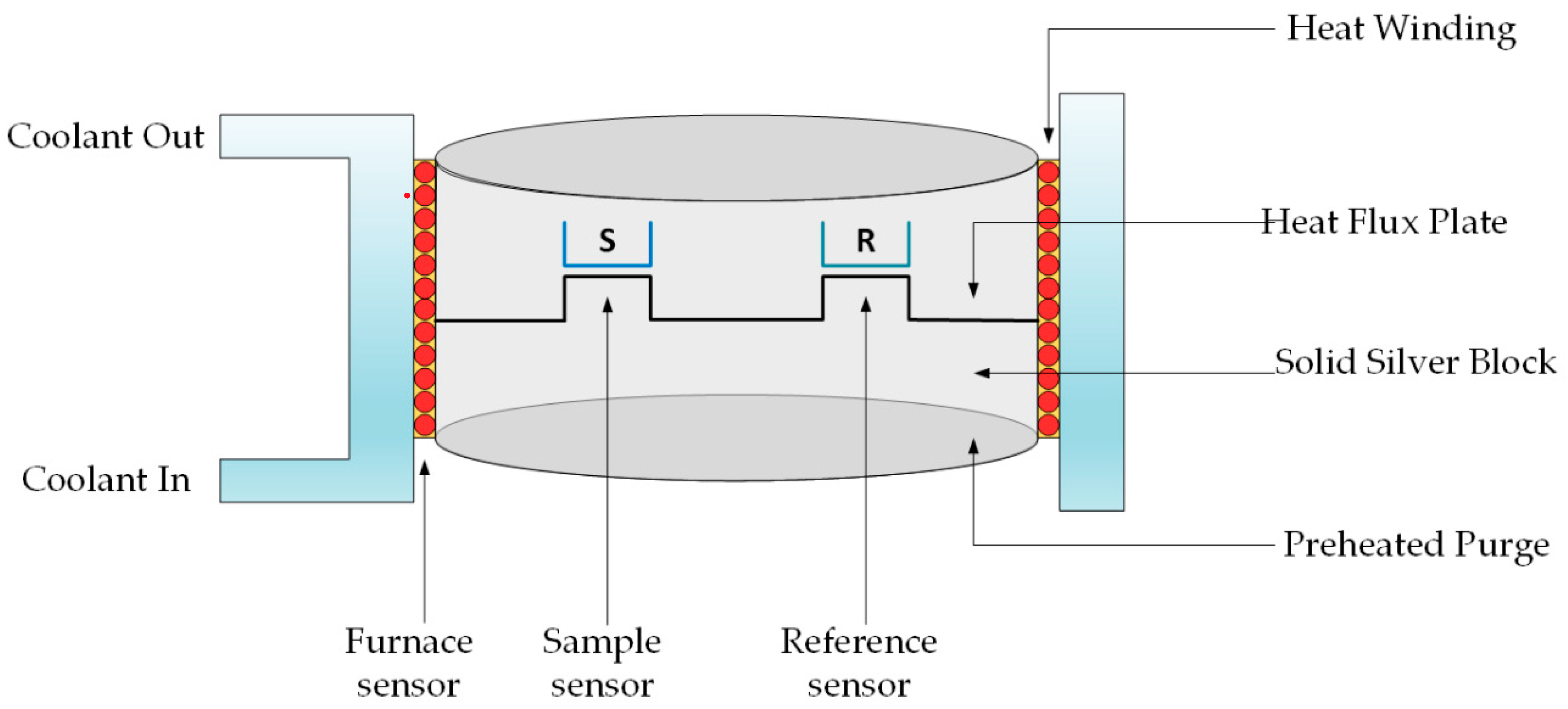
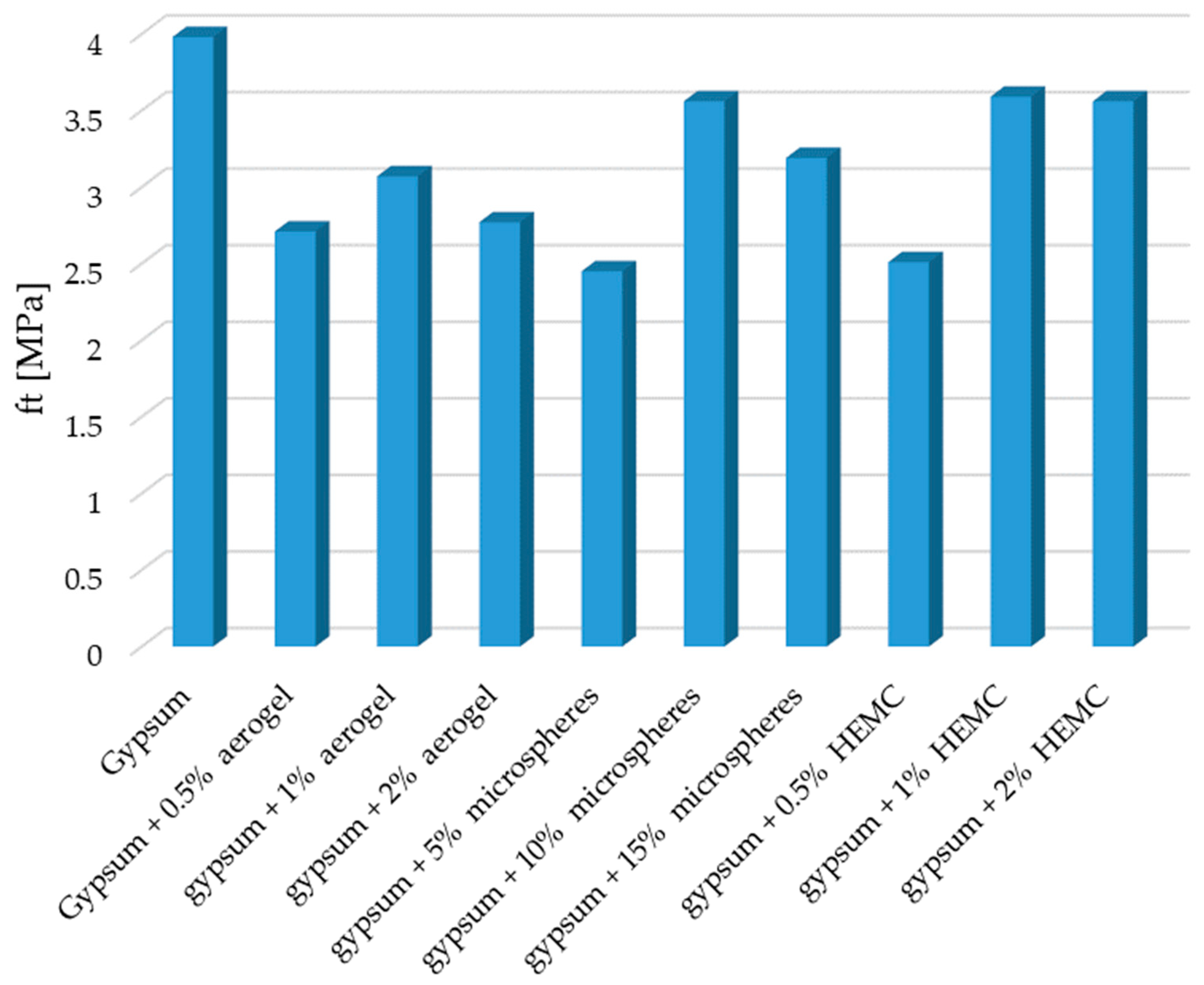
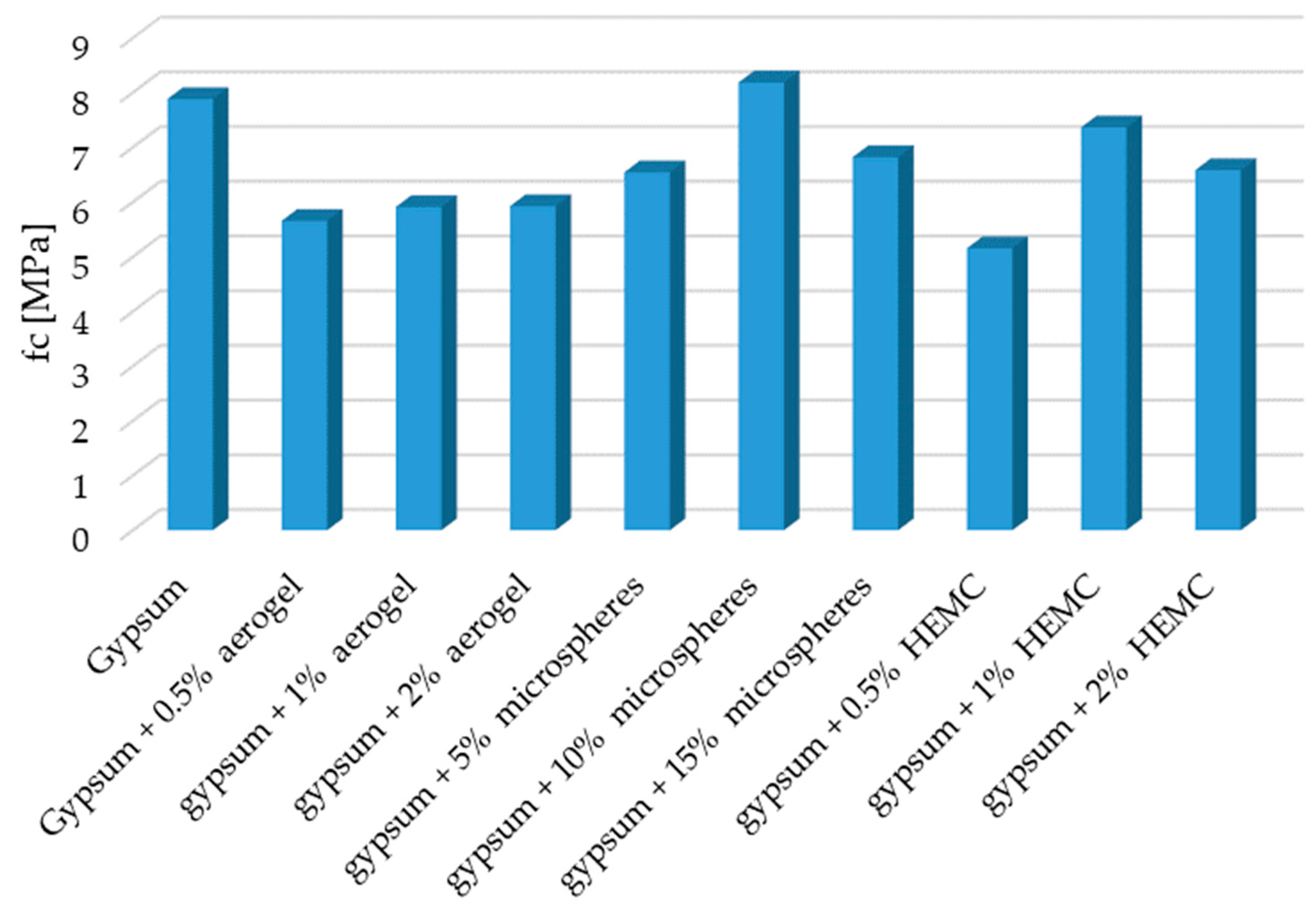

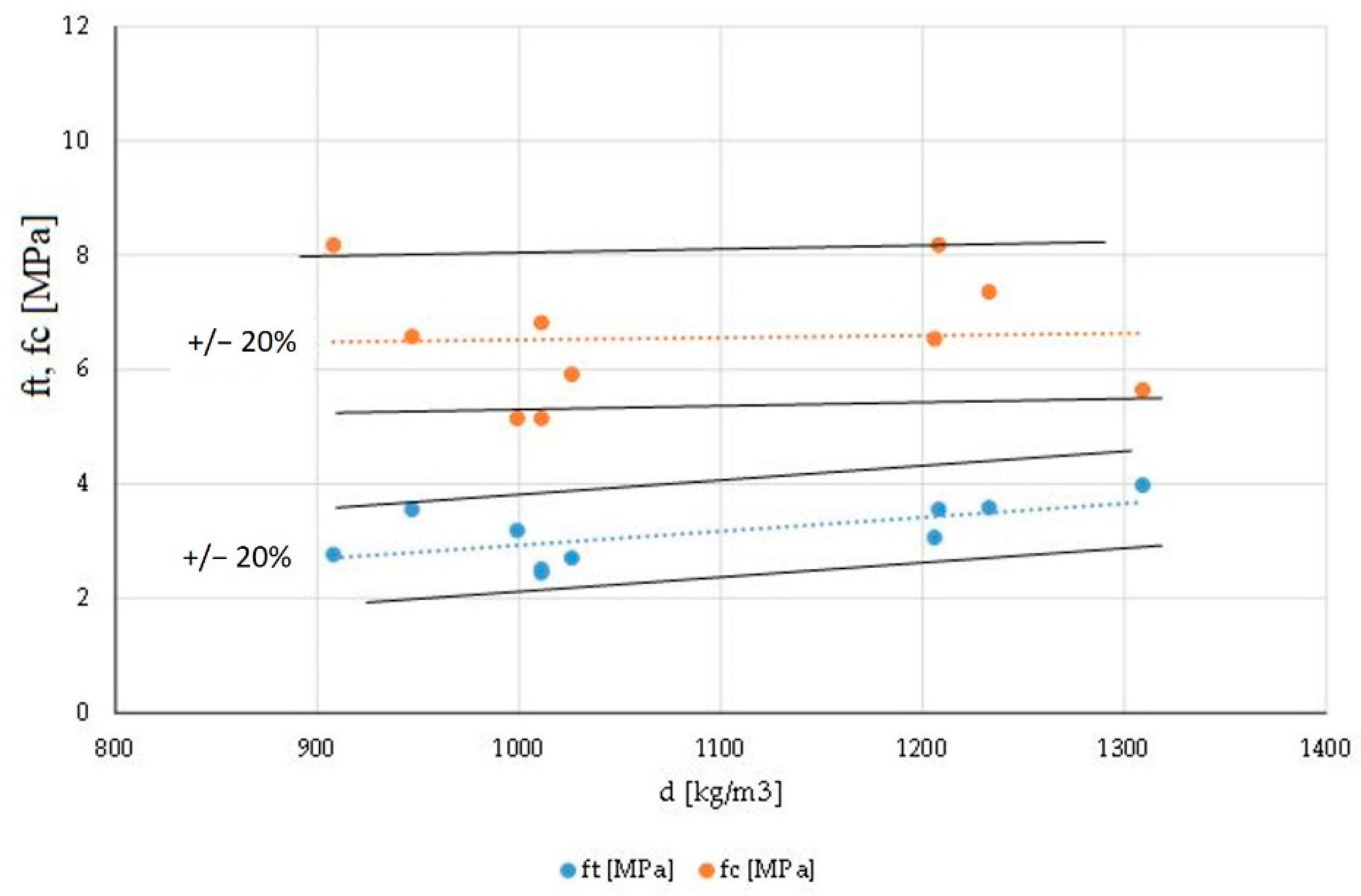
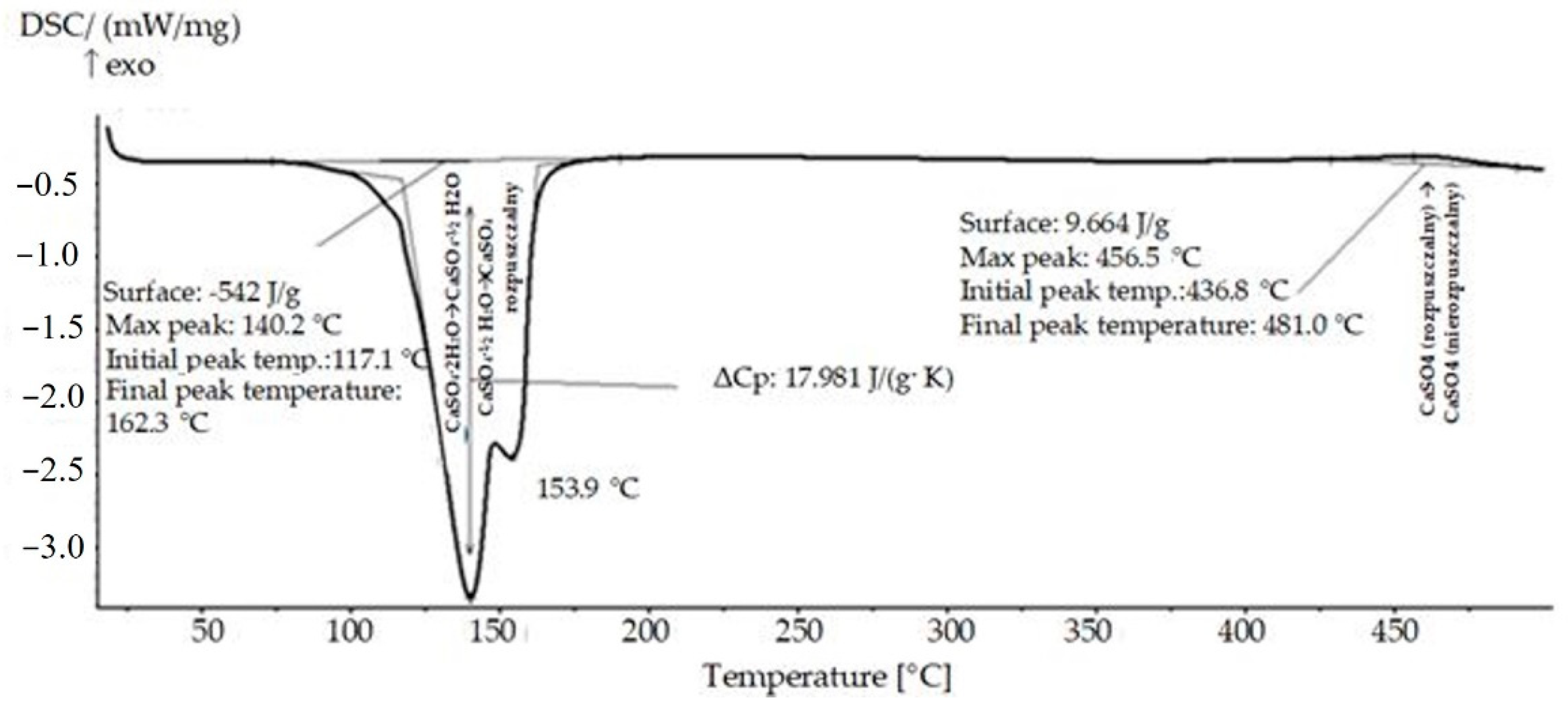
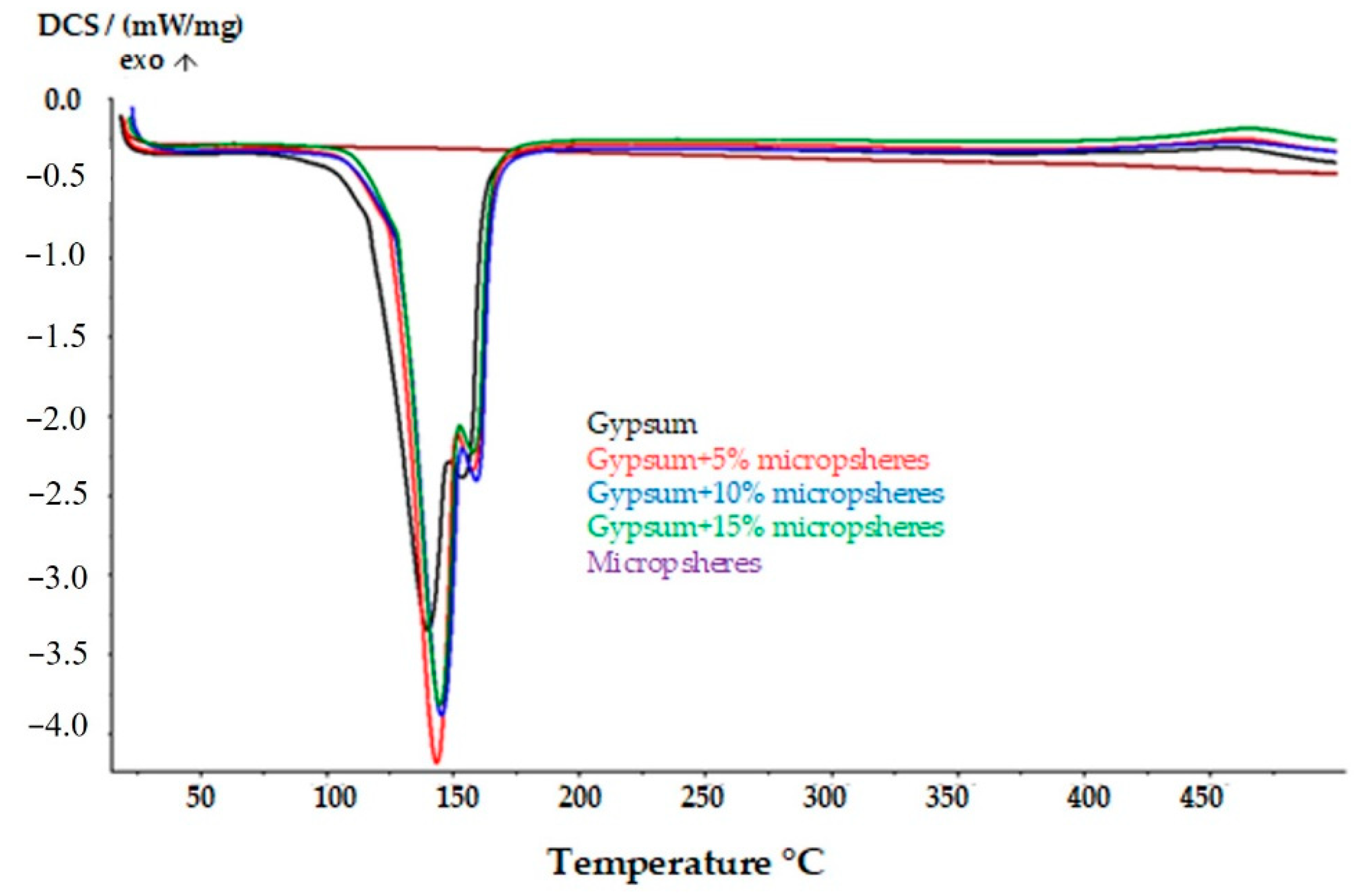
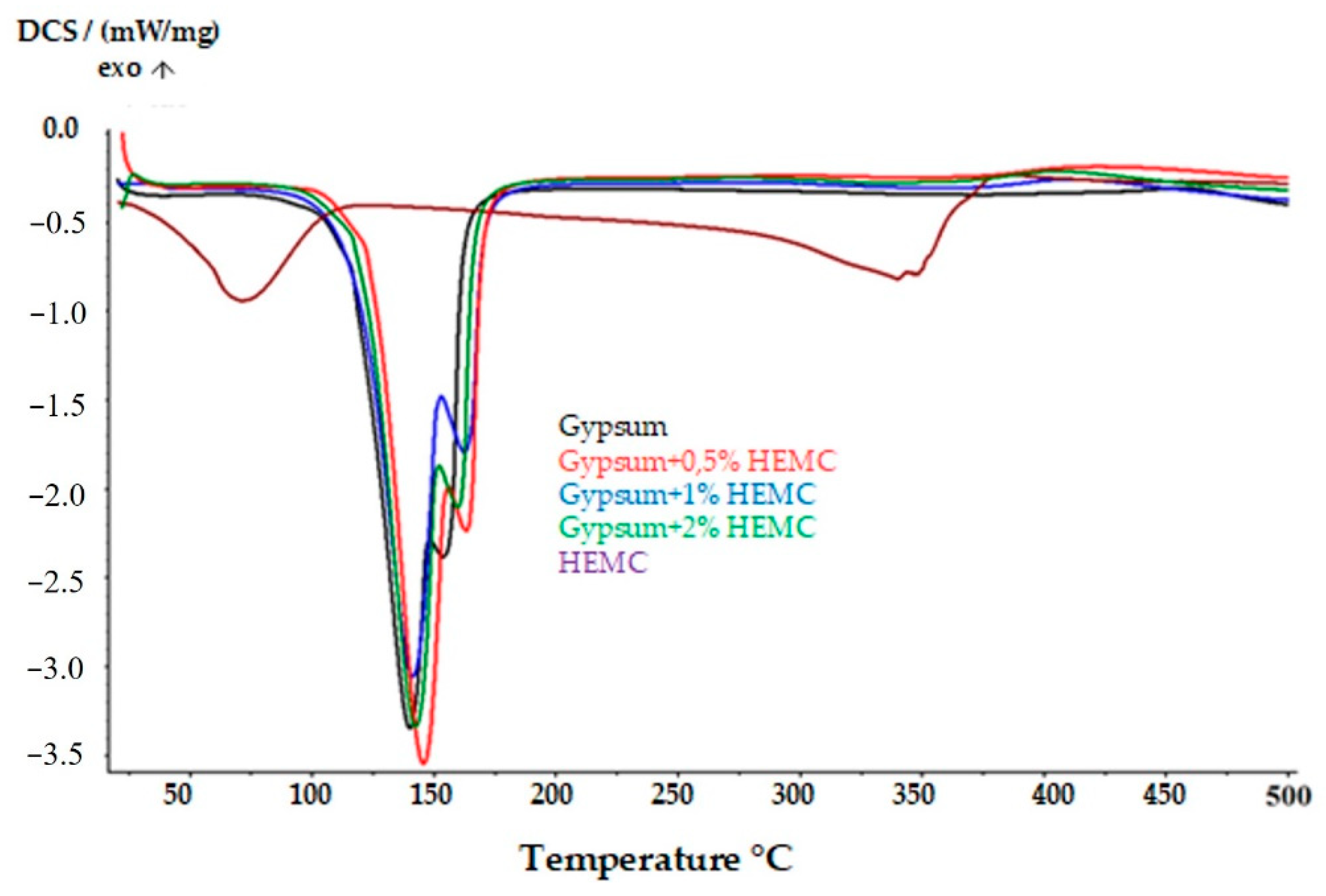
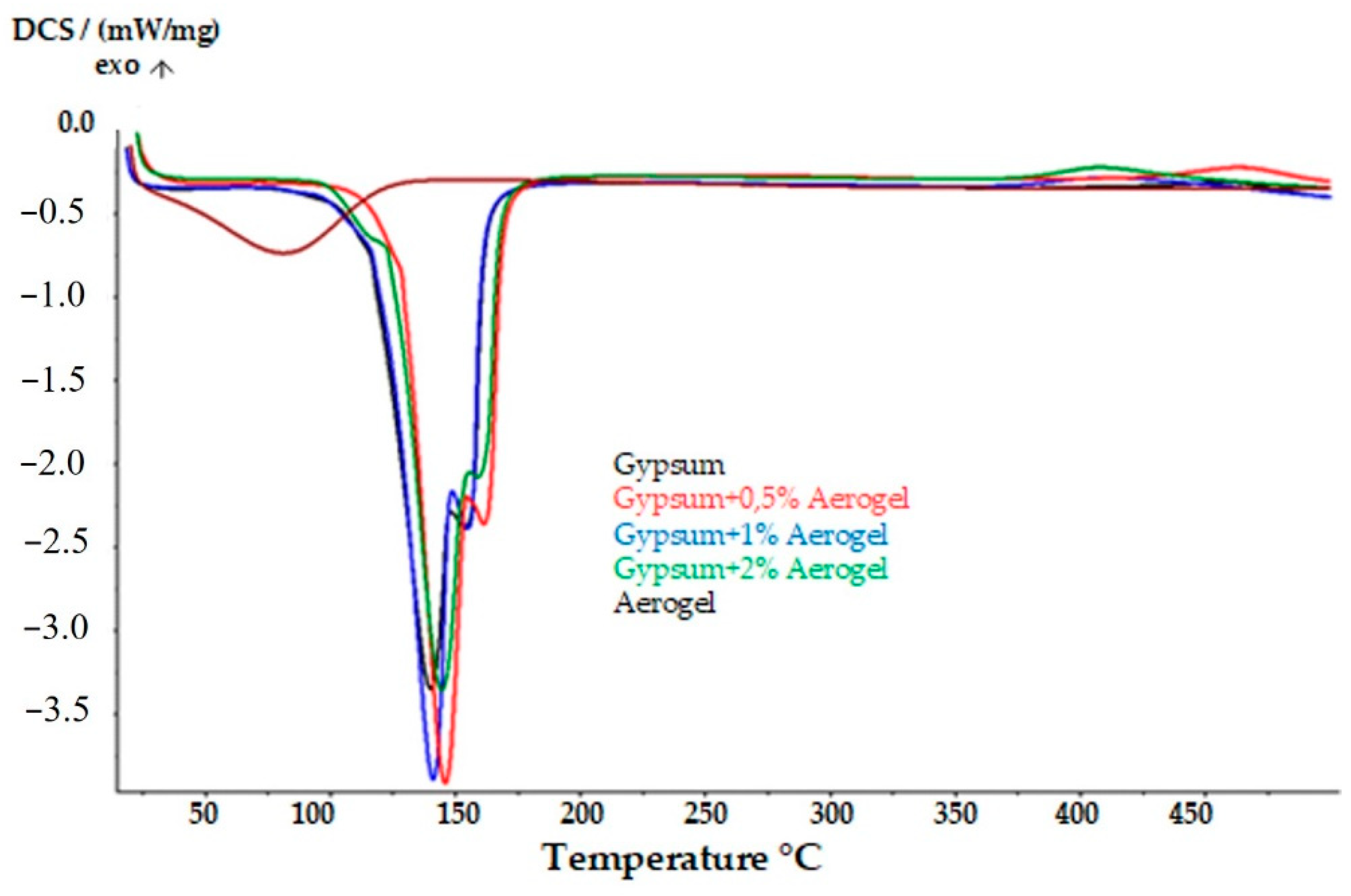
| Building Material | Relative Density d [kg·m−3] | Bulk Density dB [kg·m−3] | pH | Color | Appearance | Setting Time [min] |
|---|---|---|---|---|---|---|
| Building gypsum | 2300 | 900 | 7–8 | grey | grey–yellow powder | 3 |
| Properties of Microspheres | |
|---|---|
| Content of Al2O3 | 34–38% |
| Content of Fe2O3 | 1–3% |
| Content of SiO2 | 50–60% |
| Content of K2O | 0.1–2% |
| Content of CaO | 1–4% |
| Content of MgO | 0.2–2% |
| Content of TiO2 | 0.5–3% |
| Melting temperature | Above 1600 °C |
| Total mass | 0.378 g/cm3 |
| Grain diameter | 150–300 μm |
| Properties of Lumira LA1000 Aerogel | |
|---|---|
| Grain size range | 0.7–4 mm |
| Pore diameter | ok. 20 nm |
| Grain density | 120–150 km/m3 |
| Bulk density | 65–85 kg/m3 |
| Surface area | 600–800 m2/g |
| Thermal conductivity | 18–23 mW/(m·K) |
| Temperature at the Beginning of the Dehydration Process [°C] | Heat of Transformation [J/g] | Specific Heat [J/(g·K)] | Temperature at the Beginning of the Exothermic Transformation [°C] | |
|---|---|---|---|---|
| Gypsum | 117.1 | 542 | 17.981 | 436.8 |
| Gypsum +5% microspheres | 126.6 | 546.1 | 23.056 | 436.8 |
| Gypsum +10% microspheres | 128.6 | 517.0 | 21.184 | 429.1 |
| Gypsum +15% microspheres | 128.1 | 523.3 | 21.032 | 441.8 |
| Gypsum +0.5% HEMC | 125.1 | 568.8 | 19.439 | 383.2 |
| Gypsum + 1% HEMC | 118.1 | 533.3 | 16.358 | 382.2 |
| Gypsum +2% HEMC | 121.5 | 539.5 | 18.268 | 370.8 |
| Gypsum +0.5% aerogel | 128.4 | 551.6 | 21.48 | 441.4 |
| Gypsum +1% aerogel | 121.3 | 554.2 | 21.318 | 383 |
| Gypsum +2% aerogel | 125.5 | 565.3 | 18.311 | 382.2 |
Publisher’s Note: MDPI stays neutral with regard to jurisdictional claims in published maps and institutional affiliations. |
© 2021 by the authors. Licensee MDPI, Basel, Switzerland. This article is an open access article distributed under the terms and conditions of the Creative Commons Attribution (CC BY) license (https://creativecommons.org/licenses/by/4.0/).
Share and Cite
Ciemnicka, J.; Prałat, K.; Koper, A.; Makomaski, G.; Majewski, Ł.; Wójcicka, K.; Buczkowska, K.E. Changes in the Strength Properties and Phase Transition of Gypsum Modified with Microspheres, Aerogel and HEMC Polymer. Materials 2021, 14, 3486. https://doi.org/10.3390/ma14133486
Ciemnicka J, Prałat K, Koper A, Makomaski G, Majewski Ł, Wójcicka K, Buczkowska KE. Changes in the Strength Properties and Phase Transition of Gypsum Modified with Microspheres, Aerogel and HEMC Polymer. Materials. 2021; 14(13):3486. https://doi.org/10.3390/ma14133486
Chicago/Turabian StyleCiemnicka, Justyna, Karol Prałat, Artur Koper, Grzegorz Makomaski, Łukasz Majewski, Karolina Wójcicka, and Katarzyna Ewa Buczkowska. 2021. "Changes in the Strength Properties and Phase Transition of Gypsum Modified with Microspheres, Aerogel and HEMC Polymer" Materials 14, no. 13: 3486. https://doi.org/10.3390/ma14133486






